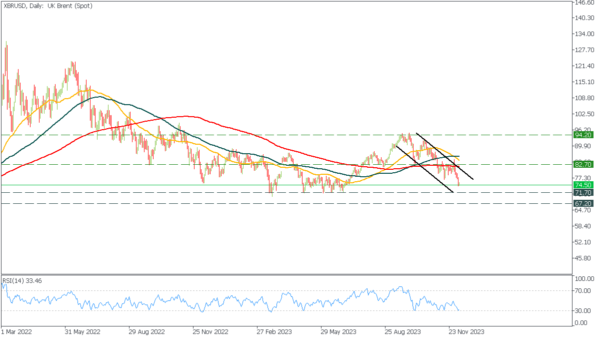The energy industry has undergone several major changes in the XXI that are becoming increasingly apparent. The global oil market, particularly Brent crude, has entered a phase of notable decline, with prices plummeting to six-month lows. This downturn reflects growing concerns over the prospects of falling fuel demand amidst various economic challenges and market dynamics.
Brent crude (XBRUSD), a leading global oil benchmark, experienced a sharp fall to $74.50 a barrel, marking the lowest level since late June this year. The decline in prices is not an isolated incident but a symptom of broader market trends and economic headwinds that are reshaping the oil industry’s landscape.
One of the key factors contributing to the oversupply in the market is the weakening demand from major global economies, notably the United States and China. The US continues to produce oil near record highs, with outputs exceeding 13 million barrels per day. This high level of production, combined with a sluggish demand in the domestic market, where gasoline stocks rose significantly beyond expectations, has added to the pressure on oil prices.
China, the largest global importer of oil, is also showing signs of reduced demand. The Chinese economy is grappling with its internal challenges, leading to a 9% drop in crude oil imports compared to last year. High inventory levels and slowing orders from independent refiners are among the contributing factors to this decreased demand.
In response to these market conditions, OPEC+ agreed to cut down oil production. This decision aims to remove around 2.2 million barrels per day from the global market in the first quarter of the next year. However, there’s a cloud of skepticism about the effectiveness and commitment to these voluntary cuts, especially considering the voluntary nature of the agreement.
Geopolitical events have also played a role but have not significantly impacted global oil flows. The ongoing conflict in Gaza and US sanctions on Russian oil are part of the complex geopolitical landscape influencing the oil markets.
The influence of the green agenda is becoming an increasingly important factor in the fossil energy market. Global environmental concerns, underscored by UN Secretary General António Guterres’ call to stop burning fossil fuels at the COP28 summit, emphasize the shift towards more sustainable energy sources.
For a more detailed analysis, we can turn to the XBRUSD chart.
XBRUSD, daily timeframe
The current technical landscape for XBRUSD reveals a bearish trend, as evidenced by the downward trajectory on the daily chart. A series of lower highs and lower lows, forming a bearish channel, signal a sustained bearish momentum.
The price is just above the critical support level at $74.50. A break below this level may lead to a decline to the next support at $71.70. Examining the moving averages, Brent crude’s price has settled below both the 50-day and 200-day moving averages. This positioning suggests a bearish market sentiment.
On the Relative Strength Index (RSI), the indicator is showing around 33.46, which is on the verge of the oversold threshold. Despite this, a potential price reversal is unlikely, as markets can remain oversold for long periods, especially in a strong downtrend.
In the short term, we can say that the price will try to reach the support level of 67.20 in December.
Summary
Despite production cuts from OPEC countries and their partners, the fall in oil prices will continue shortly. The slowdown of economic growth in the leading countries will have the strongest impact on prices. Moreover, increased logistical supplies, various sanctions, and regional conflicts will continue to restrain the growth of oil prices. Of course, it is worth keeping a close eye on further world events to continue to adjust your trading strategy, because, in times of great tension, it is worth being especially careful.













